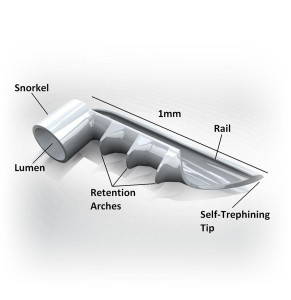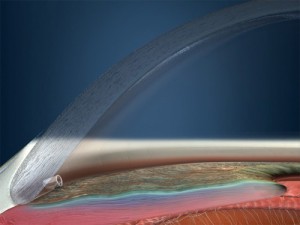iStent – Micro-Invasive Treatment for Glaucoma – Glaukos – Dr. Lewis
Serving Northeast Philadelphia, the Main Line, King of Prussia, Conshohocken, Philadelphia and Phoenixville

iStent has revolutionized the management of cataract patients with mild to moderate glaucoma. The FDA has approved iStent specifically for the treatment of glaucoma at the time of cataract extraction.
iStent | How it Works
“Bypassing the source of resistance and improving the functionality of the conventional outflow system is an ideal approach to managing OAG.”
Glaucoma is normally associated with increased fluid pressure in the eye. The primary cause of elevated intraocular pressure (IOP) in patients with open-angle glaucoma is a blockage of the trabecular meshwork; a sponge-like tissue located near the cornea and iris through which aqueous humor passes to Schlemm’s canal and into the bloodstream.
iStent:
- Creates a permanent opening in your trabecular meshwork
- Improves your eye’s natural fluid outflow to safely lower IOP
- Works continuously to improve the outflow of fluid from your eyes
- Improves outflow with a single bypass
Some Philadelphia / Bucks County cataract patients are content to continue using their glaucoma medications following cataract surgery. Unfortunately, the cost of drops and co-payments continue to rise. Furthermore glaucoma medications have systemic side effects and after years patients can develop tachyphylaxis (lower effectivity over time) and allergy to these medications. Also, immediate post-operative pressure spikes in cataract patients with glaucoma can have significant unwanted consequences. These factor motivate skilled cataract surgeons to combine cataract surgery with minimally invasive glaucoma surgery (MIGS). Similarly, many cataract and glaucoma patients prefer their surgeon address both conditions at the time of surgery. In certain cases a combined surgical procedure is absolutely necessary to maintain ocular health.
Non-penetrating deep sclerectomy (NPDS) combined with cataract surgery is another excellent choice for patients with cataracts and glaucoma. Alternative procedures like trabeculectomy, mitomycin trabeculectomy, Express Shunt, Ahmed Value, Molteno Tube and other setons significantly delay visual rehabilitation after cataract surgery. Dr. James Lewis has been performing combined cataract and NPDS for almost a decade. In particular, he uses the AquaFlow implant to maintain excellent glaucoma pressure control after cataract surgery. Visual recovering is almost immediate and comfort is maintained. Unlike full thickness glaucoma procedures, no excessive pressure fluctuations, flat chambers, choroidals, choroidals hemorrhages, macular edema or retinal hypotony occur. Cataract extraction and Aquaflow surgery as a combined procedure take less than 30 minutes, is performed under local anesthesia, use no sutures, has no foreign body sensation and does not involve cosmetic abnormalities resulting from removal of iris tissue. (Almost all other glaucoma procedures involve removing small portions of the iris and can distort the size and shape of the pupil.) Dr. Lewis has performed thousands of these procedures and is the most experienced PanOptix surgeon in the United States.
For patients with even more aggressive glaucoma, Dr. Lewis may choose to combine cataract surgery with an Ahmed Valve. Dr. Lewis began performing glaucoma tubes and valves under the auspices of Doug Coster (Australia) and Tony Molteno (New Zealand) in 1987. He was the first surgeon in the area to adopt M4, the most advanced Ahmed Valve for glaucoma.
[su_row]
[su_column size=”1/2″]
- Glaucoma Introduction
- Glaucoma Description
- How Fluid Circulates in the Eye
- Glaucoma Cause
[/su_column]
[su_column size=”1/2″]
- Glaucoma Risk
- Ocular Hypertension
- Open-Angle Glaucoma
- Narrow- Angle Glaucoma
[/su_column]
[/su_row]
Nearly one out of six patients of cataract age have some form of glaucoma. Sometimes this has not been diagnosed because glaucoma is a silent condition.

The region marked A is the cataract. Excess pressure causing glaucoma is produced at B. Their proximity help explain why cataracts and glaucoma frequently co-exist. Schlemm’s canal is the exit route for excess aqueous humor C and is the focus of the Aquaflow procedure.
In addition to helping cataracts patients with glaucoma, Dr. Lewis is also experienced in treating cataract patients suffering from astigmatism and dry eye. Dr. Lewis is one of the more experienced cataracts surgeons in the United States, and he has been recognized as a foremost Philadelphia multifocal IOL, astigmatism-correcting, and accommodating IOLs provider.
